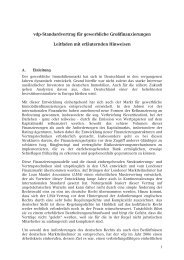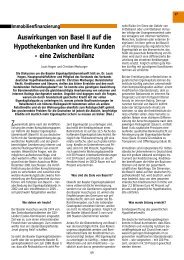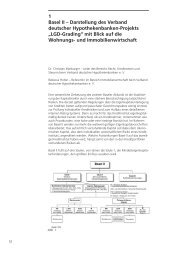The Pfandbrief 2011 | 2012
The Pfandbrief 2011 | 2012
The Pfandbrief 2011 | 2012
Create successful ePaper yourself
Turn your PDF publications into a flip-book with our unique Google optimized e-Paper software.
<strong>The</strong> Legal Framework for Issuing <strong>Pfandbrief</strong>e<br />
<strong>The</strong> individual derivatives are entered in the respective cover registers. Derivatives may have<br />
a negative value, giving rise to liabilities in respect of the cover pool. As a concession for the<br />
fact that the counterparties have to waive their right to terminate the derivative contracts,<br />
even if the <strong>Pfandbrief</strong> Bank becomes insolvent, their claims rank equal with those of <strong>Pfandbrief</strong><br />
creditors. To prevent the cover pools from becoming inordinately volatile and in order<br />
not to undermine the principle behind the cover pools, the claim or the liability under the net<br />
derivative position in each cover pool may not exceed – calculated in terms of the net present<br />
value -12% both of the cover assets and of the <strong>Pfandbrief</strong>e outstanding.<br />
Cover Register<br />
14<br />
<strong>The</strong> above-mentioned cover assets must be entered in cover registers (§ 5 <strong>Pfandbrief</strong> Act).<br />
A separate register is to be maintained for each <strong>Pfandbrief</strong> type. <strong>The</strong> entry of derivatives is<br />
subject to approval by the derivative counterparty and the cover pool monitor. This requirement<br />
reflects the above-mentioned special aspects regarding derivatives as cover assets.<br />
<strong>The</strong> cover registers, which may also be kept electronically, must be passed on to BaFin at<br />
regular intervals, where they are stored.<br />
Cover registers are, of course, highly important. All the assets recorded in one cover register<br />
belong to the respective cover pool and are, in the event of the <strong>Pfandbrief</strong> Bank becoming<br />
insolvent, subject to the cover pool administrator’s right of management and disposition.<br />
Details on the maintenance of the cover registers are set forth in the Cover Register Statutory<br />
Order (Deckungsregisterverordnung).<br />
Active Administration of the Cover Pools to Ensure Matching Cover<br />
<strong>The</strong> cornerstone of the safety of the <strong>Pfandbrief</strong> is the fact that the <strong>Pfandbrief</strong> creditors’ entitlement<br />
against the <strong>Pfandbrief</strong> Bank to payment is secured by the cover pools which, in the event<br />
of the <strong>Pfandbrief</strong> Bank’s insolvency, are to serve primarily to satisfy the <strong>Pfandbrief</strong> creditors’<br />
claims. Thus it is essential that, should insolvency occur, the cover pools contain sufficient<br />
cover assets to satisfy the <strong>Pfandbrief</strong> creditors’ claims punctually. This is achieved, first of all,<br />
in that the nominal value and the net present value of the <strong>Pfandbrief</strong>e outstanding are covered<br />
at all times by matching cover pools (§ 4 <strong>Pfandbrief</strong> Act).<br />
<strong>The</strong> Net Present Value Regulation (Barwertverordnung) stipulates in detail how the net<br />
present value is determined, and permits three methods for calculating the net present value.<br />
<strong>The</strong>se methods use different fictitious changes of interest rates and exchange rates which are<br />
to be taken into account when determining the net present value. <strong>The</strong> cover pools are subjected<br />
to defined stress scenarios, so that in effect a net present value cover surplus results.<br />
Moreover, excess cover must be maintained in net present value terms which amounts to 2%<br />
of the <strong>Pfandbrief</strong> liabilities to be covered, and which must be invested in particularly liquid<br />
assets. <strong>The</strong> purpose of this mandatory overcollateralization is, in the event of the <strong>Pfandbrief</strong><br />
Bank’s insolvency, to cover risks that may arise as well as administrative expenses payable,
















